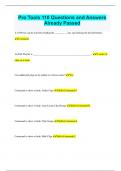Samenvatting
Samenvatting Uitgewerkte leerdoelen - Toxicologie (B-B3TOX10)
- Instelling
- Universiteit Utrecht (UU)
Uitgebreide samenvatting met daarin uitgewerkte leerdoelen voor het vak toxicologie. Daarnaast staat er een korte samenvatting in per onderdeel en staan er selftest vragen in met de bijbehorende antwoorden. In deze samenvatting is de informatie uit de hoorcolleges opgenomen en ook uit de kennisclip...
[Meer zien]














